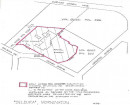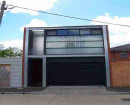FORMER CORDIAL FACTORY
8 - 12 SPRING STREET AND 14-16 ARGYLE STREET FITZROY, YARRA CITY
-
Add to tour
You must log in to do that.
-
Share
-
Shortlist place
You must log in to do that.
- Download report


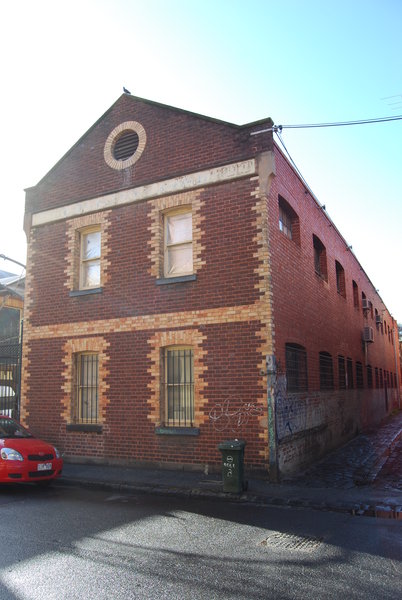
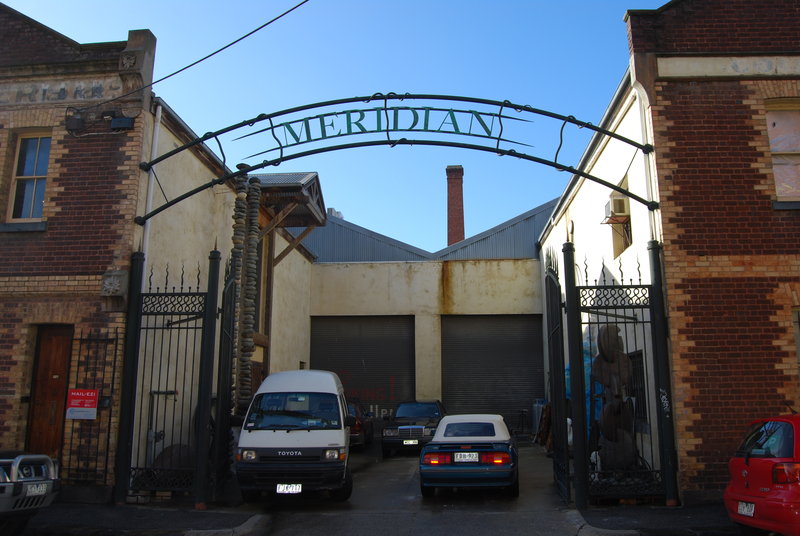
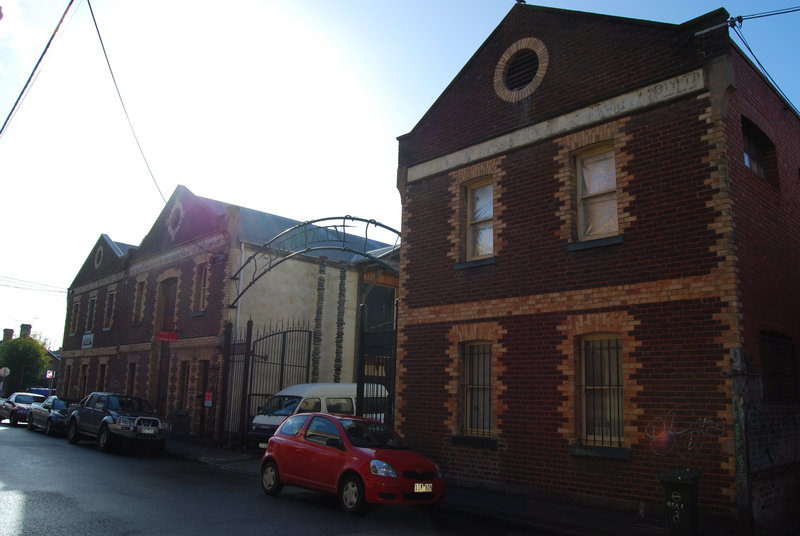
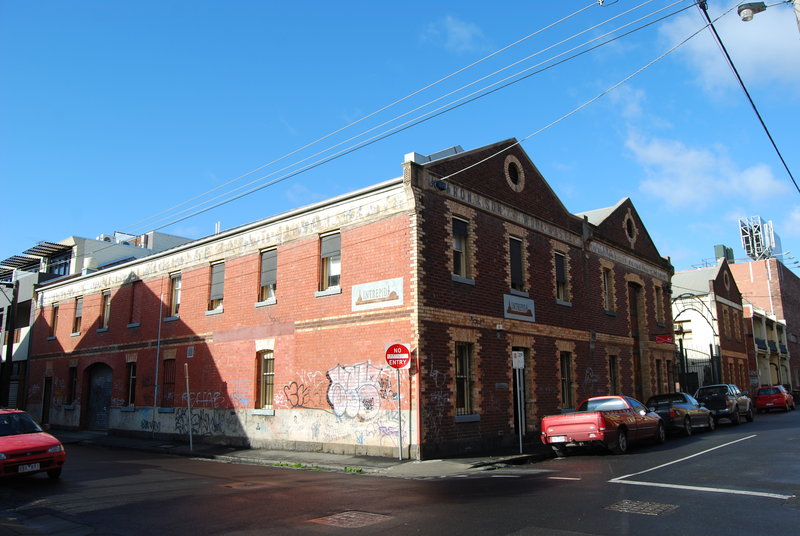

Statement of Significance
What is significant?
This former cordial factory was constructed in 1882 for Robert Harrison, and manufactured cordials and aerated waters until the 1950s.
The warm Australian climate and the advancement of the temperance movement gave rise to the popularity of 'soft' drinks in the late nineteenth century. By 1880, the Argus claimed the of consumption cordial, ginger beer and aerated waters had become 'seemingly enormous' in Victoria. A heatwave in the summer of 1889-90, which 'rendered the gasping inhabitants unfit for anything but drinking', saw shops and hotels run out of soft drink and cordial supplies. The industry mainly comprised of smaller factories distributing in their local area, with 167 factories in Victoria in 1893.
Robert Harrison began making cordial at 202 Nicholson Street in the mid 1860s, before moving to 10 Spring St, Fitzroy in 1880, where William Mercer had been operating a cordial factory since 1872. Initially operating from a weatherboard factory, the first brick section of the current building was constructed in 1882. The building was extended in the late 1890s to its present three gable arrangement. The company also owned the stables opposite the factory and from here delivered to shops across Melbourne.
Harrison's cordial factory employed forty to fifty hands and twelve wagons for the summer trade of 1888 and the growth of his business was attributed to 'strict perseverance'. By 1898, Harrison's factory was considered to be one of the three 'very important' of the 167 factories in Victoria. Harrison died later that year, and his business was continued by Vance Gregg and Charles Chapman. In 1948, a fire originating from the boiler-room caused extensive damage to the factory, and in 1953, the proprietors of R. Harrison Pty Ltd auctioned all the machinery and motor vehicles belonging to the cordial factory, and retired from business.
The closure of the factory signalled the end of more than seventy years of operation of R. Harrison's cordial factory, and nearly eighty years of continuous cordial and aerated waters production on the site. Following this, the building was used by Baron & Son Wool Waste Merchants.
The Former Cordial Factory comprises three two-storey gables fronting Spring Street with a central loading yard and a brick chimney at the rear. The building is of bichrome brick, with the walls dark brown, with cream brick detailing on the window surrounds and lower stringcourse. The business name of R. Harrison Cordial & Aerated Waters is faintly visible on the cornice on the Argyle Street elevation, and circular vents are located in the upper section of each gable on the street elevation. The building is occupied in the individual gables by two offices and a foundry. Internally, few features remain following the damage of the 1948 fire. However, timber roof trusses are extant in each section of the building, as is the original opening to the lift.
How is it significant?
The former cordial factory is of historic and architectural significance to the state of Victoria.
Why is it significant?
The former cordial factory is of historic significance for its association with the Victorian cordial industry from the 1880s until the 1950s. It is illustrative of the many localised cordial manufacturers who supplied Melbourne in the late nineteenth century as the demand for non-alcoholic refreshment grew. Harrison's factory itself is historically significant as the aerated waters manufacturer was considered to be one of the most important in Melbourne at the height of local cordial production in the late nineteenth century.
The former cordial factory is historically significant for the continuous manufacturing of cordial and aerated waters on the site for eighty years.
The former cordial factory is of architectural significance as a substantial nineteenth century brick factory building.
-
-
FORMER CORDIAL FACTORY - History
PLACE HISTORY:
Robert Harrison arrived in Victoria in July 1866, and by August had established a small ginger beer manufactory in Fitzroy. The Sands & McDougall directories of 1868-1871 list him at 202 Nicholson St, Fitzroy (near the intersection with Johnston Street). Between 1872 and 1878, Harrison's Ginger beer and cordial manufactory, was listed at 1 Johnston Street, Fitzroy and between 1878 and 1880 at 196 Nicholson Street, Fitzroy.
William Mercer had been operating a cordial factory at 10 Spring St, Fitzroy since 1872, and in 1880 Robert Harrison moved his business to the site. In 1881, Harrison was rated £40 for a weatherboard factory, and in 1882 the first section of the brick factory was constructed. It was further extended in 1884, and the premises were rated at a net annual value of £130. The 1888 publication of Victoria and its Metropolis depicted the brick factory with one gable facing Spring Street, and a double gabled structure at the rear, parallel to Spring Street. It attributed the growth of Harrison's business to 'strict perseverance'. The office was located in a weatherboard cottage was located on the corner of Spring St and what is now Harrisons Place. At this time, Harrison's Aerated Waters Cordial Works employed 'forty to fifty hands, twelve waggons and a lorry, and do a large business all over Melbourne in supplying stores and shops only'. The present building was extended with an additional two gables at a later date, and Harrison constructed the terrace houses at 2-6 Spring Street in 1889. In an advertisement from c.1880s, the 'celebrated' drinks, which were to be 'noted for purity', produced by Harrison's included Hopetta (hop beer), Jamaica brand ginger ale, ginger beer, lemonade and aerated sarsaparilla amongst others.
By the 1890s, the aerated waters and cordial industry was well established, with large manufactories and smaller local factories servicing Melbourne and Victoria, listed as 167 factories in Victoria in 1893. By 1898, there were 1000 factories across Australia, equating to approximately 1 factory for every 4000 people, compared with 1 for every 9000 people in Britain. The 'Australian Cordial Maker and Brewer Gazette' of June 1898, attributed this to the warmer climates, and noted that though the factories in Britain were more established, the number of factories showed the industry in Australia was important and well-established. It was at this time the trade gazette identified the manufactories of R. Harrison, P.G. Dixon & Co and E. Rowlands as very important in Victoria. Harrison was also on the council for the Aerated Water Manufacturer's Trade Protection Association of Victoria.
Robert Harrison died on 19 July 1898, and the business was taken over by the company's financial advisor Vance Gregg and Charles Chapman, who had worked at Harrison's for seventeen years. Gregg and Chapman continued the business as R. Harrison Pty Ltd. After the partnership dissolved, Gregg continued the business until he was bought out by R. Harrison Pty Ltd in 1933. Much of the factory building was damaged by fire in 1948. The Argus reported that the syrups room, bottling room and boiler room, where the fire started, were gutted. In June 1953, the proprietors of R. Harrison Pty Ltd auctioned all the machinery and motor vehicles belonging to the cordial factory, and retired from business. This ended a period of over 70s year operation of Harrison's cordial factory, and a nearly 80 year period of cordial manufacturing on the site. The building was later used by a wool washing firm, J. Baron & Son.
[from Victoria and its Metropolis, 1888] 'Harrison, Robert, cordial manufacturer, Fitzroy, came to Victoria in July 1866. In August of the same year he established himself at Fitzroy, manufacturing gingerbeer only, and employing at the same time only one horse and car and one man. By strict perseverance the business gradually increased, and was later greatly added to by the manufacture of aerated waters, &c. The business has greatly expanded, until now the works find employment for, in summer, from fort to fifty hands, twelve waggons (sic) and a lorry, and do a large business all over Melbourne in supplying stores and shops only. The factory, of which we show a view, is erected on freehold ground in Spring-street, Fitzroy. The business is conducted on the bonus system, which is found to act satisfactorily to all concerned.
FORMER CORDIAL FACTORY - Plaque Citation
This substantial factory was constructed in 1882 for local manufacturer Robert Harrison. Soft drinks became increasingly popular in nineteenth century Victoria because of the warm climate and the rise of the temperance movement.
FORMER CORDIAL FACTORY - Permit Exemptions
General Exemptions:General exemptions apply to all places and objects included in the Victorian Heritage Register (VHR). General exemptions have been designed to allow everyday activities, maintenance and changes to your property, which don’t harm its cultural heritage significance, to proceed without the need to obtain approvals under the Heritage Act 2017.Places of worship: In some circumstances, you can alter a place of worship to accommodate religious practices without a permit, but you must notify the Executive Director of Heritage Victoria before you start the works or activities at least 20 business days before the works or activities are to commence.Subdivision/consolidation: Permit exemptions exist for some subdivisions and consolidations. If the subdivision or consolidation is in accordance with a planning permit granted under Part 4 of the Planning and Environment Act 1987 and the application for the planning permit was referred to the Executive Director of Heritage Victoria as a determining referral authority, a permit is not required.Specific exemptions may also apply to your registered place or object. If applicable, these are listed below. Specific exemptions are tailored to the conservation and management needs of an individual registered place or object and set out works and activities that are exempt from the requirements of a permit. Specific exemptions prevail if they conflict with general exemptions. Find out more about heritage permit exemptions here.Specific Exemptions:General Conditions: 1. All exempted alterations are to be planned and carried out in a manner which prevents damage to the fabric of the registered place or object. General Conditions: 2. Should it become apparent during further inspection or the carrying out of works that original or previously hidden or inaccessible details of the place or object are revealed which relate to the significance of the place or object, then the exemption covering such works shall cease and Heritage Victoria shall be notified as soon as possible. Note: All archaeological places have the potential to contain significant sub-surface artefacts and other remains. In most cases it will be necessary to obtain approval from the Executive Director, Heritage Victoria before the undertaking any works that have a significant sub-surface component. General Conditions: 3. If there is a conservation policy and plan endorsed by the Executive Director, all works shall be in accordance with it. Note: The existence of a Conservation Management Plan or a Heritage Action Plan endorsed by the Executive Director, Heritage Victoria provides guidance for the management of the heritage values associated with the site. It may not be necessary to obtain a heritage permit for certain works specified in the management plan. General Conditions: 4. Nothing in this determination prevents the Executive Director from amending or rescinding all or any of the permit exemptions. General Conditions: 5. Nothing in this determination exempts owners or their agents from the responsibility to seek relevant planning or building permits from the responsible authorities where applicable. Minor Works : Note: Any Minor Works that in the opinion of the Executive Director will not adversely affect the heritage significance of the place may be exempt from the permit requirements of the Heritage Act. A person proposing to undertake minor works may submit a proposal to the Executive Director. If the Executive Director is satisfied that the proposed works will not adversely affect the heritage values of the site, the applicant may be exempted from the requirement to obtain a heritage permit. If an applicant is uncertain whether a heritage permit is required, it is recommended that the permits co-ordinator be contacted.Interior:
Painting of previously painted walls and ceilings provided that preparation or painting does not remove evidence of any original paint or other decorative scheme.
Installation, removal or replacement of carpets and/or flexible floor coverings.
Installation, removal or replacement of hooks, nails and other devices for the hanging of mirrors, paintings and other wall mounted art or religious works or icons.
Demolition or removal of non-original stud/partition walls, suspended ceilings or non-original wall linings (including plasterboard, laminate and Masonite), bathroom partitions and tiling, sanitary fixtures and fittings, kitchen wall tiling and equipment, lights, built-in cupboards, cubicle partitions, computer and office fitout and the like.
Removal or replacement of non-original door and window furniture including, hinges, locks, knobsets and sash lifts.
Refurbishment of existing bathrooms, toilets and kitchens including removal, installation or replacement of sanitary fixtures and associated piping, mirrors, wall and floor coverings.
FORMER CORDIAL FACTORY - Permit Exemption Policy
The purpose of the Permit Policy is to assist when considering or making decisions regarding works to the place. It is recommended that any proposed works be discussed with an officer of Heritage Victoria prior to a permit application. Discussing any proposed works will assist in answering any questions the owner may have and aid any decisions regarding works to the place. It is recommended that a Conservation Management Plan is undertaken to assist with the future management of the cultural significance of the place.
The extent of registration protects the whole site. The addition of new buildings to the site may impact upon the cultural heritage significance of the place and requires a permit. The purpose of this requirement is not to prevent any further development on this site, but to enable control of possible adverse impacts on heritage significance during that process.
The cultural heritage significance of the place is as a nineteenth century cordial factory, illustrative of the more localised cordial industry of the late nineteenth and twentieth century in Melbourne and Victoria. All of the registered building is integral to the significance of the place and any external or internal alterations are subject to permit application. Though little internal fabric remains from the building's use as a factory, the internal layout of the building, including high ceilings and window and door openings, are demonstrative of its former usage. The brick chimney located at the rear of 8 Spring Street, the loading yard dates from the cordial factory, and the reconstructed lift with original upper level wall opening, demonstrates the manufacturing and distribution purpose of the former factory.
-
-
-
-
-
LOTHIAN BUILDINGS
 Victorian Heritage Register H0372
Victorian Heritage Register H0372 -
SHOPS AND RESIDENCES
 Victorian Heritage Register H0043
Victorian Heritage Register H0043 -
POLICE STATION
 Victorian Heritage Register H1543
Victorian Heritage Register H1543
-
'ELAINE'
 Boroondara City
Boroondara City -
-oonah
 Yarra City
Yarra City -
..eld House
 Yarra City
Yarra City
-
-







